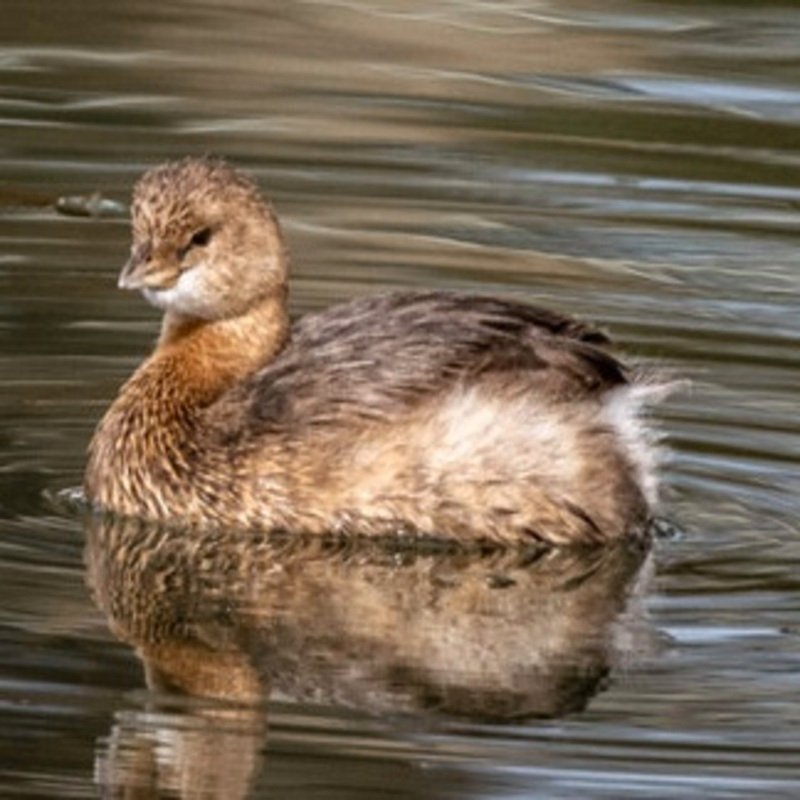The pied-billed grebe, or the Podilymbus podiceps is a grebe species. The Atitlán grebe (Podilymbus gigas) is now extinct, leaving the Pied-Billed Grebe as the only living member of the species in the family of Podicipedidae. The pied-billed grebe inhabits ponds in the Americas.
Quick Overview: Podilymbus Podiceps – Pied-Billed Grebe
Body size: Around 9-10 in (23-25 cm) and a weight of 57 g (2 oz)
Main colors: Brown, Gray, Black, White, Bluish-white
Range: Throughout the United States
Migratory Bird: Yes
Best time of the year to see in the U.S.: All Year (January – December)
Conservation Status: Least Concern
Pied-Billed Grebe Description
During mating season, pied-billed grebes have dark brown upperparts and gray neck and flanks. Their throats are black with a creamy border, and the black continues to the malars. Their eyes have a noticeable white ring. Their beak has a small hook and is bluish-white in hue with a black vertical strip in mating season. The belly, underwing, and tail coverts are all white.

Size
These birds have a length of 9-10 in (23-25 cm) and a weight of 57 g (2 oz). Their wings could range from 16-19.5 in (41-50 cm).
Feeding
The pied-billed grebe feeds on prey that is small enough for their bill to grasp. Aquatic insects and their larvae are their main prey. Fish, crayfish, beetles, and minnows are all viable food sources.
Habitat
During the breeding season, pied-billed grebes live in freshwater ponds or lakes. They prefer regions with emergent or watery vegetation for nesting. They use the same habitat in the winter as long as the water is not frozen.
Behavior
This species, like other grebes, can swim and dive well. Their feet are far back on their bodies, allowing them to rotate the tibiotarsus. They may now move their feet above, below, or level with their bodies. Pied-billed grebes are difficult to land due to their long feet.
Podilymbus Podiceps Scientific Classification
- Kingdom: Animalia
- Phylum: Chordata
- Subphylum: Chelicerata
- Class: Aves
- Order: Podicipediformes
- Family: Podicipedidae
- Genus: Podilymbus
- Species: Podilymbus podiceps
Other common name
Other names of this grebe include American dabchick, rail, dabchick, Carolina grebe, devil-diver, dive-dapper, dipper, hell-diver, pied-billed dabchick, pied-bill, thick-billed grebe, and water witch.
Best time of the year to see
In the United States, the best time of year to see these birds is all year round, regardless of the season. This refers to any month of the year between January and December.
Distribution of the Pied-Billed Grebe in the USA
Breeds from Baja California, and Nova Scotia southward across North and Central America. Winters in coastal and southern states, Mexico, and the West Indies. These species are all throughout the United States.
The Pied-Billed Grebe can be found in the following states in the United States – Alabama, Alaska, Arizona, Arkansas, California, Colorado, Connecticut, Delaware, Florida, Georgia, Hawaii, Idaho, Illinois, Indiana, Iowa, Kansas, Kentucky, Louisiana, Maine, Maryland, Massachusetts, Michigan, Minnesota, Mississippi, Missouri, Montana, Nebraska, Nevada, New Hampshire, New Jersey, New Mexico, New York, North Carolina, North Dakota, Ohio, Oklahoma, Oregon, Pennsylvania, Rhode Island, South Carolina, South Dakota, Tennessee, Texas, Utah, Vermont, Virginia, Washington, West Virginia, Wisconsin and Wyoming.

